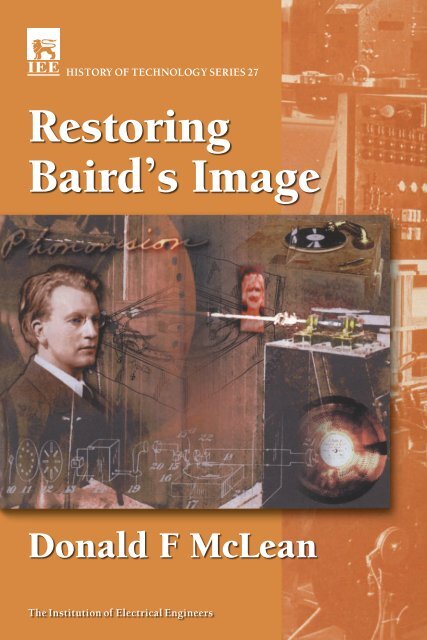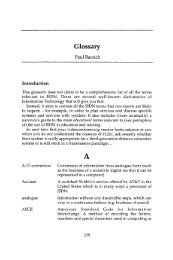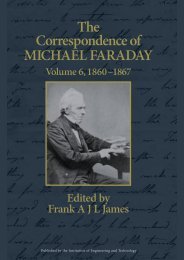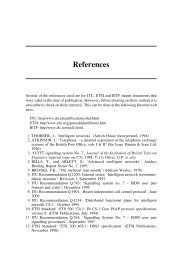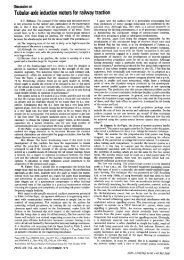Restoring Baird's Image - IET Digital Library
Restoring Baird's Image - IET Digital Library
Restoring Baird's Image - IET Digital Library
Create successful ePaper yourself
Turn your PDF publications into a flip-book with our unique Google optimized e-Paper software.
HISTORY OF TECHNOLOGY SERIES 27<br />
<strong>Restoring</strong><br />
Baird’s <strong>Image</strong><br />
Donald F McLean<br />
The Institution of Electrical Engineers
IEE HISTORY OF TECHNOLOGY SERIES 27<br />
Series Editors: Dr B. Bowers<br />
Dr C. Hempstead<br />
<strong>Restoring</strong><br />
<strong>Baird's</strong> <strong>Image</strong>
Other volumes in this series:<br />
Volume 1 Measuring instruments—tools of knowledge P. H. Sydenham<br />
Volume 2 Early radio wave detectors V. J. Phiilips<br />
Volume 3 A history of electric light and power B. Bowers<br />
Volume 4 The history of electric wires and cables R. M. Black<br />
Volume 5 An early history of electricity supply J. D. Poulter<br />
Volume 6 Technical history of the beginnings of radar S. S. Swords<br />
Volume 7 British television—the formative years R. W. Burns<br />
Volume 8 Hertz and the Maxwellians J. G. O'Hara and D. W. Pricha<br />
Volume 9 Vintage telephones of the world P. J. Povey and R. A. J. Earl<br />
Volume 10 The GEC Research Laboratories 1919-84 R. J. Clayton and<br />
J. Algar<br />
Volume 11 Metres to microwaves E. B. Callick<br />
Volume 12 A history of the world semiconductor industry P. R. Morris<br />
Volume 13 Wireless: the crucial decade, 1924-1934 G. Bussey<br />
Volume 14 A scientist's war—diary of Sir Clifford Paterson R. Clayton and<br />
J. Aigar (Editors)<br />
Volume 15 Electrical technology in mining: the dawn of a new age A. V. Jones<br />
and R. Tarkenter<br />
Volume 16 'Curiosity perfectly satisfyed': Faraday's travels in Europe<br />
1813-1815 B. Bowers and L Symons (Editors)<br />
Volume 17 Michael Faraday's 'Chemical notes, hints, suggestions and<br />
objects of pursuit' of 1822 R. D. Tweney and D. Gooding<br />
(Editors)<br />
Volume 18 Lord Kelvin: his influence on electrical measurements and<br />
units P. Tunbridge<br />
Volume 19 History of international broadcasting J. Wood<br />
Volume 20 The very early history of radio, from Faraday to Marconi<br />
G. Garratt<br />
Volume 21 Exhibiting electricity K. G. Beauchamp<br />
Volume 22 Television: an international history of the formative years<br />
R. W. Burns<br />
Volume 23 History of international broadcasting, Volume 2<br />
J. Wood<br />
Volume 24 The life and times of AD Blumiein R. W. Burns<br />
Volume 25 History of electric light and power, 2nd edition B; Bowers<br />
Volume 26 A history of telegraphy K. G. Beauchamp
<strong>Restoring</strong><br />
Baird s <strong>Image</strong><br />
Donald F McLean
Published by: The Institution of Electrical Engineers, London,<br />
United Kingdom<br />
© 2000: The Institution of Electrical Engineers<br />
This publication is copyright under the Berne Convention and the<br />
Universal Copyright Convention. All rights reserved. Apart from any fair<br />
dealing for the purposes of research or private study, or criticism or<br />
review, as permitted under the Copyright, Designs and Patents Act, 1988,<br />
this publication may be reproduced, stored or transmitted, in any forms or<br />
by any means, only with the prior permission in writing of the publishers,<br />
or in the case of reprographic reproduction in accordance with the terms<br />
of licences issued by the Copyright Licensing Agency. Inquiries<br />
concerning reproduction outside those terms should be sent to the<br />
publishers at the undermentioned address:<br />
The Institution of Electrical Engineers,<br />
Michael Faraday House,<br />
Six Hills Way, Stevenage,<br />
Herts. SG1 2AY, United Kingdom<br />
While the author and the publishers believe that the information and<br />
guidance given in this work are correct, all parties must rely upon their<br />
own skill and judgment when making use of them. Neither the author nor<br />
the publishers assume any liability to anyone for any loss or damage<br />
caused by any error or omission in the work, whether such error or<br />
omission is the result of negligence or any other cause. Any and all such<br />
liability is disclaimed.<br />
The moral right of the author to be identified as author of this work has<br />
been asserted by him/her in accordance with the Copyright, Designs and<br />
Patents Act 1988.<br />
British <strong>Library</strong> Cataloguing in Publication Data<br />
A CIP catalogue record for this book<br />
is available from the British <strong>Library</strong><br />
ISBN 0 85296 795 0<br />
Typesetting and page layout by the author<br />
Printed in England by T J International
Contents<br />
Contents v<br />
Foreword xi<br />
Preface xv<br />
Acknowledgments xix<br />
1 As Others See Us 1<br />
Videodisc comes of Age 1<br />
Mechanical Television Today 3<br />
Mechanical Computers? 3<br />
* Mechanical' Space Imaging 4<br />
Seeing at a Distance 4<br />
The World-Wide Camera 5<br />
History in 'Sound-Bites' 7<br />
Struggling with the Language of 'Techno-speak' 9<br />
What does 'Television' really mean? 9<br />
2 Distant Vision 11<br />
Revolutionary Television 11<br />
From Scratch... 11<br />
How it's Done 12<br />
From Scene to <strong>Image</strong> 13<br />
Photography 15<br />
Facsimile 17<br />
Shedding Light on Selenium 18<br />
News Facsimile 19<br />
Moving Pictures - the Movies and Television 20<br />
Cinema Television - 1930s Style 22<br />
Television 23<br />
3 The Path to Television 25<br />
Early Systems 25<br />
Nipkow's Disc 26<br />
The Scots 'invent' Television 29
vi <strong>Restoring</strong> Baird 's <strong>Image</strong><br />
The Electronic and Mechanical Paths to Television 31<br />
John Logie Baird 32<br />
The Day-Baird Letters 3 5<br />
Viewing in Reflected Light 35<br />
Viewing in Light and Shade - Television at Last! 36<br />
The First Demonstration of Television 3 8<br />
<strong>Baird's</strong> Television Format 42<br />
Non-linear Scanning 44<br />
Multiple Spirals - Multiple <strong>Image</strong>s 45<br />
Seeing at a Long Distance 46<br />
Transatlantic Television 47<br />
Demonstrations and Remonstrations 51<br />
1928 - A New Scanning Method 51<br />
4 Phonovision 57<br />
The BBC disc 57<br />
Hints of Phonovision 5 8<br />
The Search begins 58<br />
The NBTVA 59<br />
Ray Herbert 60<br />
Drawing a Blank 62<br />
The Royal Television Society 63<br />
The Baird Company Network 65<br />
Final Phonovision? 66<br />
Absence of Evidence 67<br />
Equipment 68<br />
The Phonovision Patents 71<br />
The Phonovisor Patent 74<br />
The Thinking behind Phonovision and the Phonovisor 75<br />
Publications 76<br />
Personnae 78<br />
Witness: B. Clapp 79<br />
Witness: W. C. Fox 80<br />
Witness: J. D. Percy 81<br />
Witness: T. H. Bridgewater 81<br />
Witness: C. L. Richards 82<br />
Witness: F. Whitworth 83<br />
J. Gilbert 84<br />
A Wellsian Future from the 19 th Century 84<br />
Fictional Phonovision 87<br />
Experiments and Demonstrations 87<br />
The Sound of Vision 89<br />
5 <strong>Restoring</strong> Vision 93<br />
Climbing Mountains 93
Contents vii<br />
Vision by Electricity 94<br />
Television Synchronisation 97<br />
30-line Vision Synchronisation 100<br />
What do we do without Timing? 101<br />
Early Attempts at Viewing the Recordings 102<br />
Principles behind the Restoration Process 103<br />
Phase 1 - Capture 104<br />
Pick-up Cartridge 106<br />
Centring the Disc 107<br />
Digitisation 107<br />
Phase 2 - Restoration 108<br />
Signal Processing 109<br />
<strong>Image</strong> Processing 112<br />
It's all a Question of Timing 113<br />
Pattern Matching 114<br />
Pattern Matching Methods 115<br />
Phase and Frequency 117<br />
Fourier Analysis 118<br />
Correcting for Disc Surface Faults 120<br />
Early Videodisc Defects 121<br />
Filtering 123<br />
Small Defect Detection 124<br />
Alternative Approaches 125<br />
Phase 3 - Displaying the results 125<br />
Vision restored 127<br />
6 Discoveries 129<br />
Phonovision: Genuine or Fake? 129<br />
The Columbia Graphophone Company 131<br />
Dating 'Miss Pounsford' 132<br />
Why are these Discs Phonovision? 133<br />
Valid Recording Dates? 134<br />
<strong>Baird's</strong> Recording Studio? 134<br />
The Studio in 3D 138<br />
When were the Photographs taken? 140<br />
When were the Photographs taken? 141<br />
When were the Photographs taken? 142<br />
'Phoney' Phonovisor 142<br />
Radial Tracking 144<br />
Pick-up Type 146<br />
The Bar reveals all 146<br />
Timing Faults 147<br />
'Stookie Bill' 149<br />
<strong>Image</strong> Shape 150<br />
Aspect Ratio 153<br />
Faults in Building the Nipkow Disc 153
viii <strong>Restoring</strong> <strong>Baird's</strong> <strong>Image</strong><br />
Progress in Timing 156<br />
Howling Evidence 158<br />
Torque of the Drive Motor 160<br />
Miss Pounsford's Cigarette 161<br />
'Miss Pounsford' 163<br />
Scanning Direction 164<br />
Too Fast 164<br />
'What is Wrong with this Picture?' 165<br />
Work in Progress 167<br />
7 Television Develops 169<br />
The Legacy of Baird 169<br />
An Englishman, an Irishman and a Scotsman 172<br />
Radio 173<br />
Intentions made clear 174<br />
US Experimental Television Broadcasting takes off 175<br />
Getting on Air 175<br />
The Baird Television Service 177<br />
The First BBC Television Service 180<br />
First Light 182<br />
Progress on 30-line Quality 183<br />
The New Wave 186<br />
End of the Line 188<br />
Intermediate Film - the Intermediate Answer 188<br />
All-Electronic Television takes Shape 190<br />
Television in Transition 191<br />
Trial by Television 192<br />
Airborne Reconnaissance - 1937 193<br />
<strong>Baird's</strong> Colour Television 195<br />
8 It's All in the Groove 199<br />
The First 'International' Television Service 199<br />
Audience Numbers 200<br />
The Amateurs 200<br />
Domestic Audio Recorders 202<br />
Vision Disc Transcription 203<br />
Revelations from Aluminium 203<br />
Pictures from the first BBC Television Service 205<br />
'Looking In' 208<br />
Movement - The Key to Clarity 211<br />
Reviews of the Revue 212<br />
The Games Discs 213<br />
Authentic or Fake? 215<br />
Betty Bolton 218<br />
Betty Bolton's Career 218
Contents ix<br />
Dating Miss Bolton 220<br />
Gramovision 221<br />
Major Radiovision - A Major Disappointment 223<br />
A 'Sister' Disc to Major Radiovision 225<br />
The BBC's 30-line Recording 225<br />
Changing History? 226<br />
9 Capturing the Vision 229<br />
Television - the Ephemeral Medium 229<br />
How far back? 230<br />
Pre-War British Video Recording 231<br />
The Early International Scene 232<br />
Recording Methods 233<br />
Tele-recording 234<br />
Recording - from the Beginning 237<br />
Magnetic Recording 240<br />
The Beginnings of Magnetic Tape 241<br />
Video: faster and higher 242<br />
Ampex 243<br />
The Development of the Practical Videotape Recorder 245<br />
Quadruplex versus Helical-scanning 246<br />
Helical Scanning Takes Off 248<br />
VERA Lingers 249<br />
Tape - the Fluid Medium and the Store House 251<br />
Disc Technology 252<br />
There is no time like the Present 254<br />
Who wants to live forever? 255<br />
The Explosion of Formats 255<br />
Archiving Videotape 256<br />
Dead Formats 257<br />
The End of Media? 258<br />
An Archive for the Future 259<br />
Preserving Data 260<br />
A Format for Survival 261<br />
First and Last? 261<br />
The Ultimate Archive 262<br />
10 Revising History 265<br />
Changing Views 265<br />
Over-zealous Claims 266<br />
British Television in Perspective 267<br />
Shifts in Perception 269<br />
The Evolution of Views 271<br />
'Just a Few Lines' 272<br />
A <strong>Digital</strong> Viewpoint on Television 274
x <strong>Restoring</strong> Baird 's <strong>Image</strong><br />
End of the Tube? 275<br />
The Legacy 276<br />
Conclusion 277<br />
Annex 279<br />
Derivation of Aspect Ratio from Arc-scanning 279<br />
Bibliography 281<br />
Author's Comment 281<br />
Recent Publications on Early Television 281<br />
Signal Processing 282<br />
<strong>Image</strong> Processing 282<br />
Television and Video Recording Systems 282<br />
Historical Television Books 283<br />
Biographies of John Logie Baird 284<br />
Author's Publications 284<br />
Index 287
Foreword<br />
'Well what's the good of it when you've got it. What useful purpose will it<br />
serve?'<br />
Frith Street, London on a cold wet January night in 1926, the group of<br />
eminent scientists from the Royal Institution had struggled up a series of<br />
dank narrow stairs to witness the demonstration of a new invention. On the<br />
whole, they were not impressed. Whilst most of them felt that the shrouded<br />
equipment hid some trickery, some went so far as to denounce the inventor<br />
as an 'absolute swindler'. Only a handful of the forty or so visitors that<br />
night had anything positive to say about what they had seen.<br />
In his excitement and enthusiasm the inventor seems to have misread<br />
the reaction. Writing later he said, 'I was certainly gratified by the interest<br />
and enthusiasm. The audience were for the most part men of vision who<br />
realised that in these tiny flickering images they were witnessing the birth<br />
of a great industry.'<br />
With hindsight we know that John Logie Baird was correct in his belief<br />
that it was the "birth of a great industry". We also know that no one (not<br />
even Baird) had any inkling of how great and powerful that industry was to<br />
become. With that same hindsight we can also begin to plot the changing<br />
public perceptions of <strong>Baird's</strong> achievements.<br />
By the time BBC 405-line television started in 1936, Baird had travelled<br />
from obscurity to triumph to uncertainty. A few more months and he had<br />
begun the slide back into obscurity. For the next ten years he continued<br />
research, mainly into large-screen television and high definition colour<br />
where he produced some stunning developments. These, and many of his<br />
other television "firsts" such as stereoscopy, infrared, outside broadcasts,<br />
transatlantic television, video recording and colour go unrecognised by the<br />
public.<br />
The mechanical television system he championed was, like its inventor,<br />
thrown on to the scrap heap by the mid 1930s, written off as an inferior,<br />
low-tech solution. It is rather surprising then that several elements of<br />
<strong>Baird's</strong> system resurfaced at CBS in 1950 (field-sequential colour), at<br />
Mullard in 1960 (the Banana tube) and on the moon in 1969 (Apollo 12 TV<br />
camera). Mechanical scanning is widely used today in fax machines,
xii <strong>Restoring</strong> Baird 's <strong>Image</strong><br />
supermarket checkout readers and thermal imaging cameras where it<br />
simply provides the best engineering solution for the required task.<br />
We understand the importance of these devices because we are familiar<br />
with them, with earlier inventions we have often to depend on museum<br />
collections to comprehend their status. Occasionally we come across an<br />
early technology that resists our attempts to understand it. Much of <strong>Baird's</strong><br />
work has the problem that little supporting information exists to help us. He<br />
had a huge distrust of written records and what little was written down was<br />
probably lost in the Crystal Palace fire, which destroyed his laboratories<br />
and offices. For years the historic importance of these uninspiring looking<br />
Phonovision discs eluded us - until Don tracked down six of the discs and<br />
unlocked the key to reveal the latent images. Unexpectedly, the signals<br />
recorded on a handful of seventy-year-old discs took on a new significance<br />
and I became involved with Don and Eliot Levin in a project to transcribe<br />
them on to CD for archival preservation.<br />
So it was that I arrived at Symposium Records in the summer of 1996<br />
with the surviving discs. After we had discussed the technicalities of the<br />
transcription and the timetable for the next few days, Eliot dropped his<br />
bombshell - he had found another disc. The whole story behind the<br />
discovery and restoration of this, the Silvatone disc, is covered in the book.<br />
Suffice it to say that for the next couple of days we did not know what, if<br />
anything, was on the disc. The disc surface was so badly corroded that it<br />
looked unlikely that anything useful could possibly be retrieved, but Eliot<br />
transcribed it and Don took a copy away to work his magic on it.<br />
Two days later I returned to collect the Phonovision discs. Don had<br />
made a first attempt at restoring the new disc, and with his laptop balanced<br />
precariously on a chair in the darkened corner of Eliot's living room I saw<br />
for the first time a real 30-line TV broadcast. All early television was<br />
ephemeral, live programmes, transmitted up the aerial and out into space. If<br />
you missed a programme there was no second chance. Here we had signals<br />
that by now should have been over three hundred million, million miles<br />
away in deep space but for some quirk of fate.<br />
In the normal course of my work I have become used to the unexpected;<br />
out of several hundred new acquisitions each year there will always be a<br />
few surprises, but this discovery was different. Not only was the very<br />
existence of this type of recording a complete surprise, but also the fact that<br />
anything recognisable could be retrieved from such an unpromising disc.<br />
The small flickering images I saw initially made little sense, (Don had<br />
not had time to do a lot of the subsequent restoration) but as we watched<br />
part of the sequence over and over, and as Don talked through his<br />
interpretation of the scenes, it all suddenly fell into place. With the hairs on
Foreword xiii<br />
the back of my neck literally standing on end, I realised how Howard<br />
Carter must have felt when the tomb of Tutankhamun was opened. Don and<br />
Eliot had just re-written a chapter in television history - the world's earliest<br />
domestic video recording had just shifted by over thirty years and provided<br />
us with an understanding of the style and quality of these pioneering<br />
programmes. For me, that first view of the Silvatone images was one of the<br />
main highlights of my professional career.<br />
What John Baird would have thought of this one can only guess. He,<br />
more than most, would have understood the difficulties in replaying images<br />
from these discs. I like to think he would have approved of another Scottish<br />
engineer, living in exile, working alone to complete the work he started.<br />
Baird himself never received the true recognition he deserved, a situation<br />
that will doubtless be redressed over the years to come. Don has already<br />
started that process with his painstaking research into Phonovision and<br />
mechanical television. For me, his work is an outstanding example of<br />
industrial archaeology.<br />
John Trenouth<br />
Senior Curator of Television<br />
National Museum of Photography, Film and Television<br />
Bradford, June 2000
Preface<br />
The restoration of early television images recorded on gramophone discs<br />
has increased our understanding of how television started in Britain. The<br />
discs have turned out to be time capsules of considerable historic value,<br />
made in the revolutionary age of early mechanically scanned television,<br />
dominated in Britain by the controversial, romantic visionary - John Logie<br />
Baird.<br />
The earliest of the discs are shellac pressings made by Baird during a<br />
series of experiments to record a television signal onto gramophone discs.<br />
The aim of these Phonovision experiments was to develop pre-recorded<br />
videodiscs into a consumer product. The experiments were not successful<br />
and Phonovision was all but forgotten.<br />
As a result of the recent restoration of a few surviving examples of<br />
Phonovision, we can now see in these fragments of video exactly what<br />
Baird saw, how he was trying to record television and what he was aiming<br />
to achieve. More importantly, we can now watch recordings made in 1927<br />
and 1928, mere months after Baird had given the world's first<br />
demonstration of television, during his period of exploring this new<br />
medium and over a year before the first public broadcasts in Britain.<br />
In the 1930s, soon after the first BBC Television Service had started, a<br />
few amateurs attempted to record the video signal onto aluminium<br />
gramophone discs. The discs lay unknown for decades, overlooked in the<br />
history of television. The recovery of the television images brings the first<br />
real evidence of just how good BBC Television was before the advent of<br />
high definition (405-line) television in 1936.<br />
My discovery and restoration of the television images are set out in<br />
detail yet with the minimum of mathematics. A consequence of restoring<br />
the images is being able to isolate the faults. Studying these faults yields a<br />
wealth of new information on how Baird attempted the recordings and what<br />
problems he encountered.<br />
However the restored images from Baird and from the BBC are in<br />
themselves a minor revelation. Most surprising of all is that the moving<br />
images of BBC 30-line broadcast television, not seen since they were<br />
transmitted in the 1930s, challenge long-accepted views that broadcasts
xvi <strong>Restoring</strong> Baird 's <strong>Image</strong><br />
were poor with amateurish oerformances.<br />
M. M.<br />
This book seeks to explain how video recordings could be made 25<br />
years before it was previously thought possible, why these recordings have<br />
been lost all this time, what type of television programme people sought to<br />
record, and what the BBC were doing with a Television Service in 1932,<br />
four years before television was supposed to have started.<br />
Answers to these help understand the scope of these findings and help<br />
explain a fascinating yet poorly understood period in television history. An<br />
even greater understanding comes from drawing attention to the continued<br />
importance of mechanical imaging systems right from its practical<br />
beginnings in the 19 th century to the present day. By taking a vantage point<br />
within a new age of digital communications and the Internet and at the end<br />
of the analogue television era, the book presents a fresh look at the<br />
development of television. This allows the reader to appreciate the context<br />
in which the historic video recordings were made and what led to their<br />
creation.<br />
Though it involves computers and television, this story tells of an<br />
unwitting foray into a form of archaeology, delving into a decade-long dig<br />
into Britain's engineering heritage. Unlike traditional archaeology, the<br />
artefacts are not embedded in layers of history but have existed in both<br />
private and public collections, largely ignored as curiosities. The tools to<br />
uncover and restore are not trowels and brushes but specially developed<br />
computer-based signal and image processing. The period is not some dark<br />
age in Britain's past; it is the early part of the twentieth century, a time<br />
between two of the worst wars in history and a time of great technological<br />
change. The task of restoration is not an occupation or profession, it is the<br />
result of my fascination and enthusiasm, fuelled by results.<br />
The story begins in 1981 with my recollections of how this unusual dig<br />
started. I had borrowed a documentary on audio LP disc from Harrow<br />
library. It was a light-hearted history of television narrated by the<br />
comedian, John Bird, and called 'We seem to have lost the Picture'. 1<br />
Though mildly entertaining and, as it turned out, wildly inaccurate, it<br />
included something utterly fascinating. At one point, Bird introduces a<br />
strange sound, describing it as *<strong>Baird's</strong> brain-damaging buzz-saw'.<br />
Sounding more like a swarm of angry bees, this was supposedly a recording<br />
of the vision signal from <strong>Baird's</strong> original 30-line television system. Finding<br />
this fragment was timely: I had just completed building the software to<br />
capture audio into my home-built computer and here was something to<br />
work on.<br />
On a sunny Saturday morning in late 1981,1 was huddled on the floor of<br />
my spare bedroom in Northolt with tape deck, hand-built computer and
Preface xvii<br />
oscilloscope, a tangle of wires and a tuneless chorus of various cooling<br />
fans. The green flicker of the oscilloscope trace was difficult to decipher. I<br />
was looking at what was supposed to be a video signal. I could see that the<br />
waveform repeated in a slowly changing pattern every 80 milliseconds, and<br />
another pattern repeated within it. This was undoubtedly a signal from out<br />
of history: a 30-line television signal with a picture rate of 12*/4 per second.<br />
Though documentaries and books had covered this early version of<br />
television in detail, there had never been any mention of early video<br />
recordings. Surely those recordings were worthy of at least some comment?<br />
I wrote some software to unravel the data, stored it in the computer's<br />
memory and plotted it as a 30-line picture. Against expectations, I saw the<br />
head and shoulders of a cartoon-like drawing of a man that looked vaguely<br />
like Charlie Chaplin. Though the picture was distorted and unstable, it was<br />
quite a surprise to see anything at all from the disc. How amazing! A<br />
picture embedded in the sound! The character did not move, but then the<br />
two sequences on the LP were each only a few seconds long. I cleaned up<br />
the picture, sat back and asked the question, 'I wonder if there's any more?'<br />
1<br />
'We seem to have lost the Picture' (BBC LP from the series '40 Years of Television'),<br />
1976,REB239
Acknowledgments<br />
The discovery nature of this book means that a great deal of the material<br />
presented is original and new. In addition, a considerable amount of<br />
supporting material puts the story into context with the history of imaging<br />
technology. Where possible, this material has comprised facts and<br />
photographs that are either new or have rarely before been published.<br />
I am particularly indebted to Clare Colvin of the Royal Television<br />
Society (RTS), John Trenouth of the National Museum of Photography,<br />
Film and Television (NMPFT), Nicholas Moss of the BBC and Ray<br />
Herbert for supplying photographs to use in this book. In addition I thank<br />
all those referenced for permission to use their material freely. In<br />
maintaining the book's theme of restoration and preservation, I have<br />
suppressed the defects of age, such as shading, scratches and crease-marks,<br />
in every one of the these historic photographs using off-the-shelf computer<br />
graphics software.<br />
Over the years, various people have supplied me not only with historic<br />
information but also that valuable commodity for a solo worker,<br />
encouragement. Foremost among them is Ray Herbert, whom I have known<br />
since 1982. Ray is a former Baird Company employee whose personal<br />
knowledge of <strong>Baird's</strong> achievements and whose personal archives of the<br />
Baird Company are unsurpassed.<br />
Time has taken its toll in the years since this work began; almost all of<br />
the pioneers of British television engineering from the 1920s and 1930s are<br />
now no longer with us. Amongst those, Tony Bridgewater showed probably<br />
the greatest interest in this work - particularly since he had been a Baird<br />
employee who transitioned over to the BBC for the 30-line Television<br />
Service. I remember Bridgewater and the other pioneers with respect and<br />
gratitude for their encouragement.<br />
My thanks also go to Doug Pitt and all the members of the Narrow<br />
Bandwidth Television Association (NBTVA). They keep alive the interest<br />
in those early days of television through their innovative use of technology<br />
to achieve television on amateur radio channels.<br />
This book would not have been possible without the kind support from<br />
the owners of the discs. I am grateful to H. C. Spencer, J. G. S. Ive, B.
xx <strong>Restoring</strong> Baird 's <strong>Image</strong><br />
Clapp and E. G. O. Anderson for allowing me in the 1980s to transcribe<br />
their precious discs. I hope I have made them even more precious by doing<br />
so. At time of writing, three of the six Phonovision discs are in the<br />
collection of the NMPFT in Bradford, one is in the archives of the RTS and<br />
the two remaining discs are in private hands.<br />
For the later recordings of BBC television transmissions, I am grateful<br />
for Dave Mason and Jon Weller for bringing their discs to light. I am<br />
especially grateful to Eliot Levin of Symposium Records who provided the<br />
essential transcription of those later discs and undertook the archival<br />
transfers of all the Phonovision discs for the NMPFT in 1996.<br />
The historical background on John Logie Baird was drawn in part from<br />
his autobiography. I thank Professor Malcolm Baird for permission to quote<br />
extensively from his father's book. In addition, I thank Earl Sherrin for<br />
permission to quote from J. D. Percy's unpublished memoirs.<br />
In preparing this book for publication, Martin Salter of R. H.<br />
Consultants (lately of Ampex Corporation) and Ray Herbert helped<br />
considerably by applying their extensive knowledge to check and correct<br />
the book for historical accuracy.<br />
My thanks go to Martin Eccles, Editor of 'Electronics World', for<br />
permission to re-use the title of my October 1998 article, '<strong>Restoring</strong> <strong>Baird's</strong><br />
<strong>Image</strong>' and for supporting my series of five articles.<br />
In gathering the photographic and written material that supports this<br />
book, efforts were made to track down the original copyright holders. In a<br />
few cases it may be possible that copyright has been incorrectly attributed.<br />
In that instance, I apologise for the error.<br />
I dedicate this book to my children Rhian, Malcolm and Heather, and to<br />
my wife, Lydia - the first to share in these images from the dawn of<br />
television.


